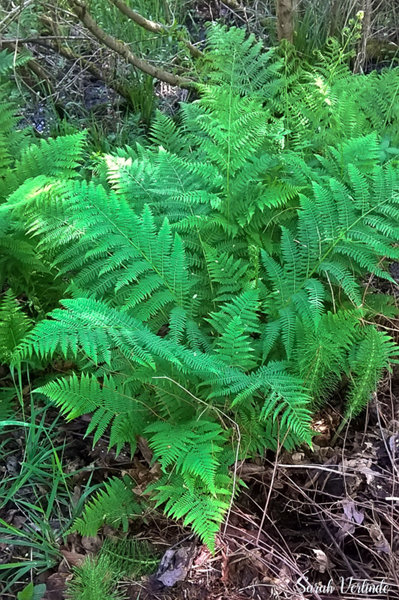Lady Fern
Lady Fern – Athyrium filix-femina ssp. cyclosorum
At a Glance:

- Family: Athyriaceae
- Plant Type: Basal deciduous fern
- Distribution: Abundant throughout North America (all states and provinces in US and Canada) and circumboreal – found through Europe and Asia as well.
- Habitat: Wetlands, moist woods and meadows, low to mid-elevations.
- Height: 2-5 feet
- Spore Season: reproductive spores are reddish-brown and appear on the underside of the leaf frond in May -September
- Leaves: bright green, lacy-looking fronds
- Generation: Perennial, leaves die back every year during fall, and new leaves form in spring.
- Notable feature: this fern can sometimes be confused with Bracken Fern (Pteridium aquilinum). Bracken ferns grow out of the ground with one stem only, then spread roots underground to send up another frond. They also tend to grow in drier areas. Lady ferns grow in moist to wet areas, and have many fronds growing out of the center base of the plant.
Restoration and Conservation
Grizzly bears, elk and deer eat the fronds of lady fern. It can be found growing in meadows, open thickets, moist woods, wetlands and colonize rock crevices.
Ethnobotany
The leaves of the lady fern were used by native tribes to cover or place food onto, especially for berry drying. The fiddleheads were eaten in early spring. Lady ferns are a very popular landscaping fern due to their graceful and lacy frond.
References and Resources
- FEIS/USDA: https://www.fs.fed.us/wildflowers/plant-of-the-week/athyrium_filix-femina.shtml
- WTU Image Herbarium: http://biology.burke.washington.edu/herbarium/imagecollection/taxon.php?Taxon=Athyrium%20filix-femina
This article was written by Jessica Rouske and Sarah Verlinde. For questions regarding the UWB/CC Plant Tour, contact Sarah at severlin@uw.edu.
